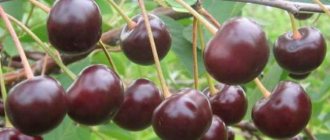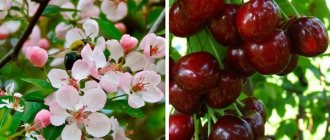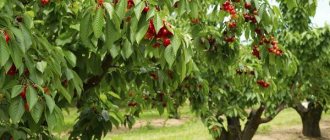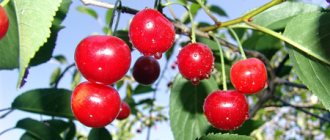How the variety was bred
This variety was obtained thanks to the work of Ukrainian breeders from the city of Melitopol. It is to this place that the cherry tree owes its name. A feature of these climatic conditions is a long, dry summer and little snow in the winter. The resulting plant is best adapted to such conditions.
Today there are 3 varieties of Melitopol cherries known:
- black (registered 1969), obtained by pollinating the French black variety;
- early (registered in 1976), bred by crossing the Franz Joseph and Early Mark varieties;
- red (registered in 1996).
These varieties differ not only in the external characteristics of the fruits, but also in the timing of their ripening. For the first time, a famous breeder from the Institute began working on obtaining this variety. M. F. Sidorenko UAAN M. T. Oratovsky.
Photo and description
A detailed description of the variety and photos make it possible to distinguish Melitopol cherries from other species by characteristic features. It is precisely this that residents of the southern regions most often settle in their garden plots to obtain a harvest of healthy berries.
general description
Large-fruited cherries are the dream of any gardener. If at the same time it does not require much attention and shows sufficient resistance to diseases, then there will not be much trouble with cultivation. Black Melitopol is exactly the variety that thanks for minimal care with a generous harvest.
Advantages
Melitopol cherries have significant advantages, thanks to which they remain a favorite among gardeners for a long time. These include:
- increased drought resistance;
- frost resistance;
- high yield rates;
- excellent taste of fruits;
- good product characteristics;
- high resistance to diseases;
- low susceptibility to the negative effects of pests.
Flaws
Despite its great advantages, Melitopol cherries are not without some disadvantages:
- self-sterile tree;
- unsuitability for cultivation in harsh climates;
- when the temperature drops greatly in winter, flower buds die;
- During return frosts in the spring, most of the pistils are destroyed.
Bud
Melitopol cherries form small cone-shaped buds that do not tolerate return spring frosts.
Leaf and flower
The Melitopol leaf blade is large, with pointed ends and characteristic jagged edges, rich green in color.
The cherry blossom period occurs at the end of May. The petals are snow-white, open wide. The flowers themselves have a strong, pleasant aroma.
Fetus
Melitopol fruits are valued not only for their excellent taste, but also for their excellent commercial qualities, large size, and universal use.
Weight
Ripe cherries weigh about 8 g, but larger specimens are also found.
Height
The height of the Melitopol berry reaches 2.7 cm.
Width
The width of the fruit ranges from 2.5 to 3 cm.
Thickness
The wall thickness of cherry fruits is large; the pit occupies less than 5% of the total volume.
Color
When ripe, the flesh of Melitopolskaya acquires a beautiful dark red color, and its skin becomes red-black with a glossy sheen.
peduncle
The stalk of this cherry variety is medium in size and divided into 2-3 glands.
Bone
The Melitopol seed is small, occupies about 4.5% of the total volume of the fruit, and has a beige color.
Melitopol black
The variety is recommended for cultivation in the southern regions and the North Caucasus District. People call Melitopol cherries Bird Cherries and Sweet Cherries because of the great love of birds for them, which destroy up to 40% of the harvest.
Description
Melitopol black cherry grows quickly, often reaching a height of 6 m. The spreading, dense crown of a spherical contour is densely leafy, formed by raised branches.
Cherry Melitopol
The foliage is serrated and has pointed tips. It will take a seedling only 4 years to produce its first harvest. Black cherries are well preserved and suitable for transportation. That is why Melitopol cherries were cultivated on an industrial scale.
Berries
Ripe berries have a dark, almost black color. All are covered with barely noticeable gray specks. In their native region, cherries ripen from mid-June. Fruit sugar content is more than 13%, acidity is minimal.
Sweet cherries are large with thin but fairly dense skin, about 8 g, but they are also found weighing 12 g. Ripe fruits can stay on the branches for almost a month without rotting or falling off. They come off the stalk easily without damage.
The dark red flesh is elastic; when crushed, a rich burgundy juice is released. The bone is small and comes off effortlessly.
Cherry berry
Pollination, yield
This cherry variety is cross-pollinated. In order for the ovary to appear, other cherries or sweet cherries are needed in the neighborhood. The only condition is that the trees bloom at the same time. The best pollinators are Large-fruited, Surprise. The varietal crops Kurortnaya, Kosmicheskaya, and Daibera black pollinate well.
general characteristics
Melitopolskaya is a variety with an average harvest ripening period. The fruits begin to be harvested in mid-June. Also, to obtain a bountiful harvest, it is necessary to plant pollinating varieties nearby. The first fruits are enjoyed 5 years after the seedling is planted in the garden.
Taste qualities
Melitopolskaya has excellent taste. The fruits have the perfect balance of sweetness and acidity. Tasters rate their merits at 4.9 points.
Nutrient content
The Melitopol variety of cherries is a real storehouse of vitamins and nutrients. It contains:
- zinc;
- copper;
- manganese;
- cobalt;
- iron;
- phosphorus;
- magnesium.
The predominant vitamins in cherries are B1, B2, B6, B9, A, E, P and, of course, vitamin C.
Tree height and growth rate
The Melitopolskaya tree grows very quickly and rapidly, but its height does not exceed 3 m, which allows harvesting without special equipment.
Flowering and ripening period
Melitopol cherry blossoms begin in mid-May, and the harvest ripens in the second half of June. The fruits ripen together, almost simultaneously.
Productivity
An adult cherry tree of the Melitopol variety, subject to the conditions of agricultural technology and proper shaping, can produce up to 80 kg of high-quality ripe fruit.
See also
How to properly grow cherries from pits at home and rules for caring for seedlingsRead
Transportability
Dense pulp and skin make cherries suitable for transportation over long distances without loss of commercial qualities.
Drought resistance
Melitopolskaya is a drought-resistant variety and can easily tolerate prolonged absence of moisture.
Frost resistance
Cherry of this variety has good frost resistance. In winter, it can withstand temperatures as low as -25 °C.
Disease resistance
Melitopol has increased resistance to moniliosis and gray rot. It is affected by fungal infections only in conditions of high humidity and in the absence of preventive treatments. But the plant needs mandatory prevention against coccomycosis.
The most common pests that attack cherries are:
- cherry fly;
- caterpillar;
- aphid;
- kidney weevil;
- sawfly.
Melitopol early
This variety of cherries has bright red, not very large, medium-sized fruits. Their shape is flat-round, slightly lumpy. The juicy pulp contains white veins. Mixed fruiting of early Melitopol cherries occurs 3 years after planting the seedling. The first ripening of the berries was noted at the end of May.
The self-sterile variety is pollinated by other cherries that bloom at the same time. The Rubinovaya rannaya and Bigaro Burlat varieties act as good pollinators.
Bigaro Burlat
Landing Features
The quality and quantity of the future cherry harvest largely depends on the correct choice of planting material and compliance with planting rules, so this procedure must be taken responsibly.
Selection of seedlings
The choice of seedling is the key to success in obtaining tasty and healthy berries. There are a number of requirements for young plants in order for them to develop normally and be healthy.
Root system
A seedling with a closed root system can be planted on the site during the entire growing season by transferring it from the pot into the ground. But cherries with an open root system should be planted only before the buds begin to bloom. The roots must be well developed and show no signs of disease, rot, mold or mechanical damage.
Trunk
A cherry seedling suitable for planting must have a trunk thickness of 15-17 mm. The bark is not allowed to have stains, deep scratches, or other visible deformations.
Age
Melitopol cherries take root best if the tree is 1-2 years old at the time of planting.
Availability of vaccinations
The varietal characteristics of the plant largely depend on the grafting, as well as on what rootstock was used to grow the planting material. In young cherries, the grafting site is still clearly visible, so you must definitely pay attention to this and check with the seller which rootstock was used in this case.
Choosing a landing time
Melitopol cherries with an open root system are planted at a time when they are still dormant and the buds have not begun to bloom. In spring, this time is the end of March - the first half of April, and in the fall, work is carried out immediately after the end of leaf fall. Before the onset of cold weather, the seedling must have time to take root well.
Site selection
Melitopol cherries are planted in well-lit areas. It is advisable to set aside a place for this in the south side of the garden, which will be reliably protected from drafts and strong winds. There should be no stagnation of excess rain or melt water .
Pit preparation
The pit for planting a seedling should be prepared in advance. If planting is planned for spring, then preparations begin in the fall. A mixture of humus or compost with the top fertile layer of soil is added to the bottom in a 1:1 ratio. If necessary, other sparingly soluble fertilizers (for example, superphosphate) are added there. If the site is dominated by acidic soil, then it would be advisable to add dolomite flour in small quantities.
The depth of the planting hole is about 0.6 m, and its width is 0.8 m. The distance to neighboring trees or shrubs is left at least 4-4.5 m.
Landing
Before planting, the cherry seedling is immersed with its root system in water with a root formation stimulator diluted in it for a couple of hours. After this, the main stem is cut off at a height of 0.6 m. In the planting hole, the soil at the bottom is formed in the form of a small mound, on which the tree is carefully placed and its roots are straightened. A peg for garter is driven in nearby and the hole is filled with nutritious soil mixture. The root collar should be above the ground level, and the grafting site should be slightly higher .
The soil around the Melitopol cherry is compacted, watered abundantly and mulched with hay or mown grass.
Pollinators
Melitopolskaya is a self-sterile variety and requires mandatory planting nearby of trees of another variety with similar flowering periods. Only in this case will it be possible to get a generous harvest from it.
Ruby early
A fast-growing tree with a spherical crown. A variety with early ripening. The cherries are small in size and dark red in color. The pulp is juicy, tasty, meaty. Ruby early has increased resistance to common diseases, produces abundant harvests, is drought-resistant, and tolerates low temperatures in winter. The taste qualities of cherries are rated by tasters as dessert. The harvest is suitable for transportation.
Skorospelka
Cherry with a very early ripening period and high yields. The fruits are suitable for transportation over long distances, which makes Skorospelka profitable for growing for commercial purposes. The crown is not prone to thickening, which makes pollination effective, and ripening cherries receive a sufficient amount of sunlight. The variety is drought-resistant, withstands winter temperature drops, and has good immunity to diseases. A minor drawback is that it is demanding on the soil.
See also
Description and characteristics of the Michurinskaya cherry variety, planting and careRead
Valery Chkalov
One of the time-tested varieties that has not lost its popularity among connoisseurs of delicious fruits. Cherry is cold-resistant, drought-resistant, with good immunity to diseases. Chkalov belongs to the early varieties and pleases with a bountiful harvest already in mid-June. The maximum height of the tree reaches 6 m. When ripe, the cherries become dark red, heart-shaped, weighing up to 8 g each. Their taste is sweet, with a slight sourness.
Secrets of care
To get a good harvest, it is important not only to plant a tree, but also to be able to properly care for it.
Watering
A young cherry seedling requires that the soil around it be constantly moist. This can be achieved through regular watering. An adult tree especially needs watering during the following periods:
- budding;
- formation of ovaries;
- before the onset of frost;
- during periods of drought.
Water is poured into the irrigation furrow, which should be done in advance. Its size corresponds to the crown radius.
Top dressing
Immediately after planting, Melitopol cherries do not need fertilizing. Fertilizers are applied for the first time after the tree begins to bear fruit. In the spring, you will need to incorporate urea into the soil, and in the fall, use urea and potassium. Before the onset of cold weather, a layer of organic matter is poured into the tree trunk circle: compost or humus. In areas with acidic soil, a small amount of lime or dolomite flour is applied every 5 years .
Pruning using the Spanish bush method
Since Soviet times, the following method of growing a tree has been used: the crown of the cherry tree is formed according to the principle of a sparse layer: a tree with one main trunk up to 7 m high. However, over the years, fruiting deteriorated, the berries were set almost at the very top and it was problematic to collect them. Modern technologies make it possible to restrain the growth of green mass and direct the forces of Melitopol cherries to the formation of ovaries.
When the crown is formed using the popular Spanish bush type method, the height of the plant does not exceed 3 m, and harvesting is carried out without special equipment.
In the first year, the seedling is pruned at a height of a maximum of 0.7 m. Over the summer, side branches will grow on it. Of these, the 4 strongest are left, growing in different directions upward, and the rest are pinched. As soon as the length of the remaining main branches reaches 0.5 m, they are cut off at the same level. The tops that grow after such pruning of cherries should be regularly cut out.
In the second year, all main shoots of the second order are shortened to 0.3 m so that they are at the same level. In mid-summer, third-order growths should already reach a height of 0.5 m. They are pulled to a horizontal position using weights, and the remaining young shoots are trimmed to a length of 0.3 m. In the third and subsequent years, the cherry tree will already be formed. You will only need to periodically shorten the branches that extend beyond the crown and do a little thinning.
Prevention from birds
To prevent Melitopol cherries from becoming a delicacy for birds, by the time the fruits ripen, a small fishing net or other similar material is thrown over it. If the tree is small, then a frame is first built for these purposes.
Cherry Melitopol large-fruited
The large-fruited variety of Melitopol cherries is late-ripening.
The fruit tree does not exceed 3 m, which is convenient for caring for it. The rootstock easily adapts to new conditions; the description of the variety includes a note that it has good frost resistance.
The tree has a luxurious spreading crown, gray-brown bark, and large oval leaves. The fragrant flowers have white petals that open wide.
This late variety has very large sweet fruits (10.5-12 g) with a light intoxicating aroma. Aromatic and healthy cherry juice is made from ripe berries.
Harvest and storage
Melitopol cherries are harvested in mid-June. The work is carried out both manually and using mechanized means. Fruits can be stored in the refrigerator for up to 14 days. The harvested crop is consumed fresh or used for any type of processing or harvesting. It is noteworthy that after freezing the cherries do not flow and retain their shape well.
Reviews
During the existence of the variety, many gardeners have personally tried Melitopol cherries, growing them in their own gardens. Of course they are willing to share feedback.
Marina Eduardovna: “After studying reviews on the Internet, I decided to purchase two varieties of cherries for the garden: Melitopol and Valery Chkalov. We had to wait a long time for the harvest. When they managed to collect the first fruits, the whole family was very happy: the cherries grew unusually large, sweet and beautiful to look at. There was no big hassle with leaving. We limited ourselves to molding the crown, applying fertilizers and systematic watering. They did not treat for diseases, so as not to once again pollute the earth with chemicals. But I planted flowers with a strong aroma around the perimeter to repel pests.”
Nikolai Grigorievich: “I’ve been growing Melitopol for a long time. There was no need to plant a pollinator, because two varieties of cherries grow on the neighboring plot. I would like to note that in our gardening community there are problems with water supply, so it is not possible to water the garden regularly. But even in such difficult conditions, the tree produces a stable harvest of fruit every year. We eat part of the harvest fresh, and from the rest we make small preparations for the winter.”
Nina Sergeevna: “I planted Melitopolskaya on the advice of friends. After 4 years, the tree produced its first harvest. The soil on my site is depleted, so I constantly have to apply fertilizers and feed the cherries. If this is not done in time, the fruits become smaller and the plant sheds some of the ovaries. Over the course of several years, I have already gotten used to this regime and try to feed on time. The variety suits me: the harvest is enough not only to provide a family of 3 people with fresh cherries, but also to make preparations.”
Feeding
Cherries are fertilized like other fruits: in the spring - with nitrogen, later - with potassium compounds, and in the second half of summer or autumn - with superphosphate. By pruning, a sparse crown is formed, and dry, broken branches growing inward are removed. To combat diseases and pests, preventive and therapeutic spraying is carried out. These manipulations are known to every gardener.
For early cherries, you will additionally have to take care of protection from birds. To do this, a special net is placed over the crown or various repellent devices are hung.











